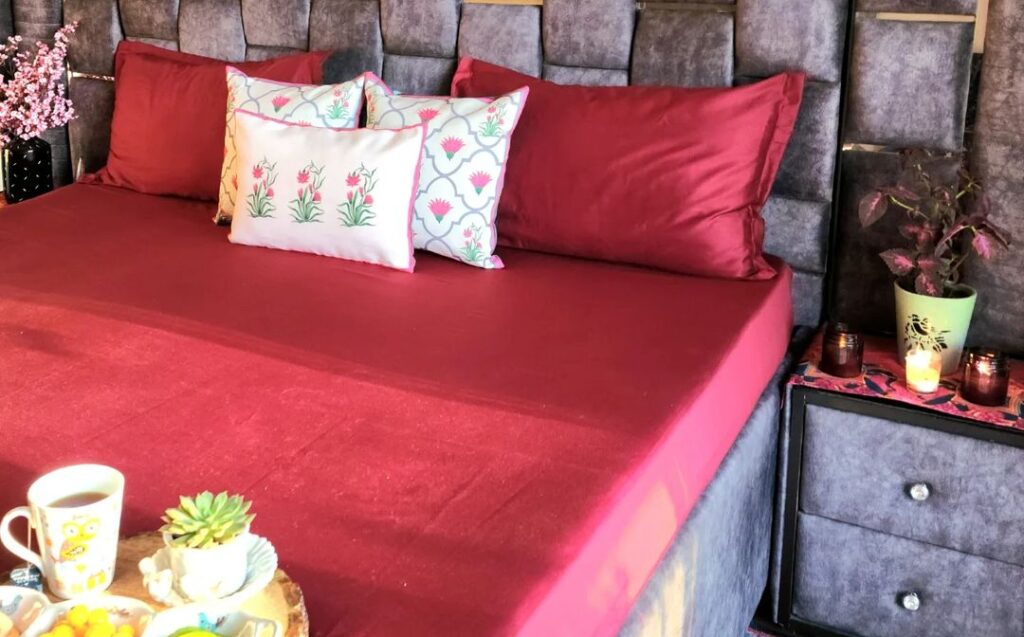Satin and Sateen: The Basics
Before we dive into the details, let’s get a better understanding of satin and sateen:
Weave:
- Satin: Satin fabric is known for its glossy surface. It has a unique weave that creates a smooth and lustrous finish.
- Sateen: Sateen, on the other hand, features a soft and smooth finish. It’s made using a different weaving technique than satin.
Fibers:
- Satin: Satin is typically made from filament fibers like silk or synthetic materials.
- Sateen: Sateen is made from short-staple spun yarns, with cotton and rayon being common choices.
Luster:
- Satin: Satin boasts a high sheen that beautifully reflects light, giving it a striking, almost mirror-like appearance.
- Sateen: Sateen, while still lustrous, offers a more subtle glow, imparting an elegant radiance to the fabric.
Uses:
- Satin: Due to its opulent appearance, satin is often reserved for formal occasions, such as special events or decorative elements in the bedroom.
- Sateen: Sateen, with its softer and more versatile characteristics, is perfect for everyday use, ensuring both comfort and style.
Price:
- While sateen sheets have a premium feel, they are surprisingly affordable. This makes them an excellent choice for those seeking a touch of luxury without breaking the bank.
AVIS Bedlinen’s Choice
Now that you have a clearer picture of the differences between satin and sateen, let’s explore why AVIS Bedlinen has chosen sateen for their cotton bed sheets:
Natural Fabric: Sateen is made from natural fibers, typically cotton, which is a breathable and comfortable material. This makes it an excellent choice for bed sheets as it helps regulate temperature and wicks moisture away.
Everyday Luxury: Sateen’s subtle luster and soft finish give it a luxurious feel that’s suitable for everyday use. Whether it’s for a cozy night’s sleep or to enhance your bedroom decor, sateen has you covered.
Affordability: Unlike satin, sateen provides a premium experience without the premium price tag. AVIS Bedlinen’s commitment to quality and affordability means you can enjoy the benefits of sateen without overspending.
Shopping for bed linens can be an exciting but daunting experience. Amid the vast selection of prints and colors, it’s essential to have a good grasp of the fabrics and materials involved. You’d be forgiven if you ever came across the terms “sateen” and “satin” and thought they were mere variations of each other. In reality, these two materials are quite distinct. Furthermore, shoppers often find themselves mixing up satin and silk due to their similar appearances.
If you’re on the quest for luxurious bed sheets, this guide will provide a valuable breakdown of sateen vs. satin. We’ll also touch upon sateen vs. silk bedding to help you distinguish between these options. Ultimately, we aim to steer you toward the bedding products that align with your lifestyle.
What is Sateen?
Sateen isn’t a material per se; it’s a weaving technique. Sateen weaving involves a pattern of one yarn passing under and four (or more) weft threads. This results in a thicker, warmer, and heavier sateen texture with a subtle sheen that exudes luxury.
While sateen can technically be manufactured with various fibers like cotton, polyester, and rayon, the quality of the material depends significantly on the choice of fibers. For the highest-quality sateen, AVIS Bedlinen opts for 100% premium cotton, such as Egyptian cotton. This blend ensures a fabric that’s not only incredibly soft but also doesn’t overheat your body.
The Pros and Cons of Sateen
Sateen predominantly employs shorter-staple cotton fibers, resulting in a fabric that’s soft, strong, and possesses a subtle sheen. Additionally, sateen bed sheets drape beautifully and are naturally wrinkle-resistant. However, due to their thickness, some individuals may find sateen traps heat, making it less suitable for hot sleepers.
Caring for sateen sheets is a breeze. AVIS Bedlinen recommends washing them in cool water with a mild, non-toxic detergent and tumble-drying on low heat. Avoid hot water and high-heat drying, as these may harm the fabric.
What is Satin?
Satin, despite its resemblance to silk, is not the same. The key distinction lies in their composition: silk is a raw material, whereas satin is a weaving pattern. Satin is characterized by its glossy, lustrous front and a less shiny back, achieved through floating warp yarns across the weft before passing under a single weft thread.
Satin can be produced using various fibers with long filaments, such as silk, polyester, and nylon. The final product is durable and boasts an attractive drape, making it a popular choice in fashion items.
However, when it comes to bedding, satin faces some challenges, particularly in breathability and maintenance.
The Pros and Cons of Satin
Satin’s luxurious feel and durability are balanced by reduced breathability, especially when synthetic fibers are used. This heat-trapping characteristic might not be ideal for bedding where comfort and temperature regulation are vital. Additionally, satin bed sheets may require specific care, with silk varieties often necessitating dry cleaning.
Choosing the Right Bedding Material
When it comes to quality bedding, AVIS Bedlinen offers a range of sateen options. We prioritize 100% premium cotton, creating a strong, soft, and lustrous sateen fabric. Our sateen products include fitted sheets, top sheets, comforters, and soft pillowcases, providing a luxurious look for your bedroom.

